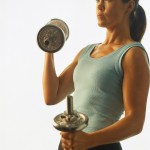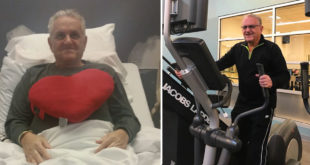by Michelle Sutton-Kerchner
You don’t have to be a tennis player to suffer from “tennis elbow.” This condition puts a wrench in your joint, even if you never swung a racket. You may need to tweak your workout, and daily activities, for a quick, productive recovery. Here’s how …
Tennis elbow earned its name from the repetitive movements executed in tennis that sometimes injure the tendon and muscle area surrounding the elbow. However, overuse or an abrupt jolt to the arm and forearm muscles result in the lingering pain associated with this condition. Half of all tennis players are affected by this at least once in their careers. However, it does not discriminate: Less than five percent of those diagnosed overall actually play tennis.
The pain originates where muscles and tendons of the forearm attach to the outside area of the elbow (lateral epicondyle). Feel free to refer to this condition as lateral epicondylitis. It may impress someone enough to carry your bags for you. This condition mainly affects one’s dominant arm because it takes the most wear-and-tear throughout the day. Everything from ergonomics at your desk to carrying groceries and laptop bags stresses this joint and leaves it susceptible to such injury.
A personal trainer can help you identify stressors and provide corrective-movement techniques. Practicing proper form while exercising, including when lifting weights, decreases the likelihood of injury or exacerbation. Some suggest wearing an elastic bandage around the forearm to absorb force taken in the area. Worn just below the injured elbow, it may help alleviate pain.

A physician usually diagnoses tennis elbow upon examination. Any additional tests, such as x-ray, MRI, or EMG, may be performed to eliminate other possibilities. Key risk factors include regular activities that involve repetitive arm, elbow, and wrist movements. Bowling, baseball, and similar sports tend to increase your odds. House cleaners, mechanics, and carpenters may be more susceptible. Men tend to suffer from this condition more often than women, as well as those between ages 30 and 50 years.
ID It
The onset of tennis elbow is often subtle. It usually creeps in slowly around the outside of the elbow, where you’ll feel pain or burning. You may not know which action triggered it, although you can hope it was the match-point swing. Pain worsens when performing everyday tasks, such as shaking hands, squeezing objects, opening jars, and holding utensils or a toothbrush. Occasionally, tennis elbow may strike suddenly, but not often.
Although similar, tennis elbow should not be confused with golfer’s elbow (medial epicondylitis). Golfer’s elbow presents as pain on the inside of the elbow, not the outside as in tennis elbow. It may also extend along the inside of the forearm, causing weakness in hands and wrists and possibly tingling and numbness in fingers. Golfer’s elbow may onset suddenly, which is rare in tennis elbow.
Incorrectly lifting weights may trigger golfer’s elbow. Do you curl your wrists during bicep exercises? A simple slip like this can stress the elbow’s muscles and tendons, making you prone to golfer’s elbow. Team with a personal trainer. A single session can provide an overview of your routine. Learn which moves are bringing you closer to fitness goals and which may lead you to the couch.

Treat It
Your first plan of action should be no action at all for the elbow. It requires rest, so plan your activities without emphasis on that arm. You can still exercise through this injury. A personal trainer can suggest exercises that advance your fitness program without involving the affected elbow. If there was a specific activity or sport that triggered your tennis elbow, avoid it for several weeks so the area has time to properly recover.
Physical therapy is often suggested. Specific exercises executed with the assistance of trained therapists can help loosen and strengthen the muscles surrounding the joint. A therapeutic exercise program can be built upon on the Exercise Floor to advance further. By properly targeting the muscles involved (when appropriate), you promote healing as well as take proactive measures against future injury.
Research indicates recovery is faster and more successful when exercise and physical therapy are included in the process. A safe workout helps restore mobility and flexibility. Being in your best physical condition is always beneficial, though especially when recuperating from an injury. Cardio exercises increase heart and lung capacity, as well as overall strength and endurance. Aerobic in nature, they can be performed without strain on the elbow. Improved blood circulation brings more fresh oxygen to the tendons, which increases healing.
After therapy or exercise, surround the injured elbow with ice. A pliable ice pack can wrap around your entire elbow, as can a bag of frozen veggies. You may experience some soreness for a short period afterward, but without rehabilitative exercise therapy, tennis elbow may not improve. Actual pain (beyond soreness) should be discussed immediately with your therapist or trainer. This can signal improper execution, duration, or the need to decrease reps.
In most cases, conservative treatments work—rest, physical therapy, rehabilitative exercise, and anti-inflammatory over-the-counter medication. Only about five percent of those affected with tennis elbow will require surgery to repair the muscle-tendon unit around the elbow. When unavoidable, surgery has an 80 to 90 percent success rate, where pain is relieved and strength returned.
Repeat Offenders

If tennis elbow becomes a frequent occurrence, consider having your athletic equipment checked. For example, the size, stiffness, and string on racquets can interfere with stress placed on the forearm. An oversized racquet might be replaced with a smaller one to prevent recurrence of symptoms.
Try Pilates or personal training sessions. A minor adjustment to your game play (swing, stroke, or roll) or regular activities might be the simple solution. An occupational therapist may be able to improve your worksite conditions. Techniques and ergonomic adjustments can increase comfort and efficiency.
Follow the advice of your physician, physical therapist, and personal trainer through each step of your recovery. A proper exercise program can make an impressive difference in the body’s ability to heal. An improper one can keep you benched, unable to so much as punch a cheering fist in the air as your team scores without you.
Sources
“Exercise and Physical Therapy for Tennis Elbow,” by Shannon Erstad at www.webmd.com.
“Golfer’s Elbow” at www.mayoclinic.com.
“Tennis Elbow,” American Academy of Orthopaedic Surgeons at www.orthoinfo.aaos.org.
Image Credits
Wrapped elbow (introductory photo): www.flickr.com/photos/breatheindigital/4569728474/
Vacuum: www.flickr.com/photos/nominaali/3468393215/
Woman with weights: http://picasaweb.google.com/lh/photo/ARw1VFJiLc0jSU7veq6NtA
Racquet swing: www.flickr.com/photos/brunogirin/3652460476/
 Fitness & Wellness News Your Source for Fitness News, Wellness News, Health News, and Nutrition News!
Fitness & Wellness News Your Source for Fitness News, Wellness News, Health News, and Nutrition News!



